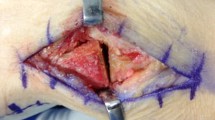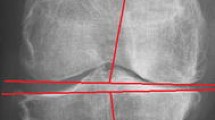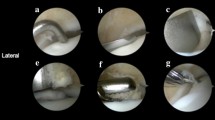Abstract
In a prospective, randomised study, 27 patients with internally fixed ankle fractures were treated post-operatively for a period of six weeks by application of either a new dynamic vacuum orthosis with permitted mobilisation to 10°–0°–10° at the ankle joint or a synthetic cast. Full weight bearing was allowed in both groups after two weeks. The cast group was prescribed four weeks of physiotherapy following six weeks of immobilisation. After ten weeks, the Olerud and Molander score showed a significant difference in favour of the orthosis. Early functional outcomes were significantly better for this group after six weeks and ten weeks. Patients in the orthosis group who were in formal employment returned to work 24 days earlier than those in the control group. Treatment of the orthosis patients took up three to four times less working time for the medical personnel. A saving of 38 euros on directly ascertainable costs could be evaluated. Rehabilitation of ankle fractures with a dynamic vacuum orthosis leads to better early functional results and greater patient satisfaction. The orthosis fulfils the conditions for early return to work. Treatment with an orthosis not only reduces working time for medical personnel but economises on expenditure for treatment and rehabilitation.
Résumé
Une étude randomisée a été réalisée chez 27 patients présentant une fracture de la cheville et traités sur une période de six semaines soit par une orthèse dynamique permettant une mobilisation de 10° dans chaque secteur soit par une immobilisation plâtrée. Une marche avec appui complet a été autorisée dans les deux groupes, après 15 jours. Le groupe des patients plâtrés a bénéficié de 4 semaines de rééducation après six semaines d’immobilisation. Après 10 semaines, le score d’Olerud et de Molander montre une différence significative dans les résultats en faveur de l’orthèse. En effet, le devenir fonctionnel de ces patients a été de façon significative bien meilleur pour ce groupe après six semaines et après dix semaines. Ces patients sont retournés au travail 24 jours plus tôt que dans le groupe contrôle. Le traitement par orthèse permet d’économiser 38 euros et du temps médical. La rééducation de la fracture des chevilles grâce à l’orthèse dynamique permet un résultat fonctionnel excellent et relativement rapide. Cette orthèse met les patients dans de bonnes conditions pour un retour précoce à l’emploi, ce traitement permet également d’économiser le travail des médecins et permet également de faire des économies sur le temps de rééducation.



Similar content being viewed by others
References
Project Nr. 0894–2401, BASiS Institut, TUEV Product Service. 2005a. Ref Type: Generic
Project Nr. 0896–2402, BASiS Institut, TUEV Product Service. 2005b. Ref Type: Generic
Ahl T, Dalen N, Lundberg A, Bylund C (1993) Early mobilization of operated on ankle fractures. Prospective, controlled study of 40 bimalleolar cases. Acta Orthop Scand 64:95–99
Akeson WH, Amiel D, Abel MF, Garfin SR, Woo SL (1987) Effects of immobilization on joints. Clin Orthop 28–37
Augat P, Merk J, Ignatius A, Margevicius K, Bauer G, Rosenbaum D, Claes L (1996) Early, full weight bearing with flexible fixation delays fracture healing. Clin Orthop 194–202
Cimino W, Ichtertz D, Slabaugh P (1991) Early mobilization of ankle fractures after open reduction and internal fixation. Clin Orthop Relat Res 152–156
Dietrich A, Lill H, Engel T, Schönfelder M, Josten C (2002) Conservative functional treatment of ankle fractures. Arch Orthop Trauma Surg 122:165–168
Egol KA, Dolan R, Koval KJ (2000) Functional outcome of surgery for fractures of the ankle. A prospective, randomised comparison of management in a cast or a functional brace. J Bone Joint Surg Br 82:246–249
Goodship AE, Cunningham JL, Kenwright J (1998) Strain rate and timing of stimulation in mechanical modulation of fracture healing. Clin Orthop 105–115
Ingle BM, Eastell R (2002) Site-specific bone measurements in patients with ankle fracture. Osteoporos Int 13:342–347
Knight KL, Londeree BR (1980) Comparison of blood flow in the ankle of uninjured subjects during therapeutic applications of heat, cold, and exercise. Med Sci Sports Exerc 12:76–80
LeBlanc A, Gogia P, Schneider V, Krebs J, Schonfeld E, Evans H (1988) Calf muscle area and strength changes after five weeks of horizontal bed rest. Am J Sports Med 16:624–629
Lehtonen H, Jarvinen TL, Honkonen S, Nyman M, Vihtonen K, Jarvinen M (2003) Use of a cast compared with a functional ankle brace after operative treatment of an ankle fracture. A prospective, randomized study. J Bone Joint Surg Am 85-A:205–211
Lindsjo U (1985) Operative treatment of ankle fracture-dislocations. A follow-up study of 306/321 consecutive cases. Clin Orthop 28–38
O’Sullivan ME, Bronk JT, Chao EY, Kelly PJ (1994) Experimental study of the effect of weight bearing on fracture healing in the canine tibia. Clin Orthop 273–283
Olerud C, Molander H (1984) A scoring scale for symptom evaluation after ankle fracture. Arch Orthop Trauma Surg 103:190–194
Partio EK (1992) Immobilization and early mobilization of malleolar fractures after osteosynthesis with resorbable bone screws. Unfallchirurgie 18:304–310
Pathare N, Walter GA, Stevens JE, Yang Z, Okerke E, Gibbs JD, Esterhai JL, Scarborough MT, Gibbs CP, Sweeney HL, Vandenborne K (2005) Changes in inorganic phosphate and force production in human skeletal muscle after cast immobilization. J Appl Physiol 98:307–314
Ponzer S, Nasell H, Bergman B, Tornkvist H (1999) Functional outcome and quality of life in patients with Type B ankle fractures: a two-year follow-up study. J Orthop Trauma 13:363–368
Ruedi TP, Murphy WM (2000) AO Principles of Fracture Management-AO teaching videos on CDrom. Stuttgart, AO Publishing-Thieme Verlag. Ref Type: Generic
Salter RB (1989) The biologic concept of continuous passive motion of synovial joints. The first 18 years of basic research and its clinical application. Clin Orthop 12–25
Siddique A, Prasad CVR, O’Connor D (2005) Early Active Mobilization versus Cast Immobilization in operatively treated ankle fractures. European J Trauma 32(4):398–400
Stockle U, Konig B, Tempka A, Sudkamp NP (2000) Cast immobilization versus vacuum stabilizing system. Early functional results after osteosynthesis of ankle joint fractures. Unfallchirurg 103:215–219
van Laarhoven CJ, Meeuwis JD, van der Werken C (1996) Postoperative treatment of internally fixed ankle fractures: a prospective randomised study. J Bone Joint Surg Br 78:395–399
Vandenborne K, Elliott MA, Walter GA, Abdus S, Okereke E, Shaffer M, Tahernia D, Esterhai JL (1998) Longitudinal study of skeletal muscle adaptations during immobilization and rehabilitation. Muscle Nerve 21:1006–1012
Author information
Authors and Affiliations
Corresponding author
Rights and permissions
About this article
Cite this article
Franke, J., Goldhahn, S., Audigé, L. et al. The dynamic vacuum orthosis: a functional and economical benefit?. International Orthopaedics (SICO 32, 153–158 (2008). https://doi.org/10.1007/s00264-006-0306-5
Received:
Accepted:
Published:
Issue Date:
DOI: https://doi.org/10.1007/s00264-006-0306-5




